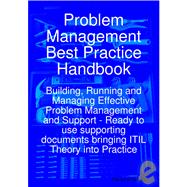Problem Management Best Practice Handbook : Building, Running and Managing Effective Problem Management and Support - Ready to use supporting documents bringing ITIL Theory into Practice
, by Blokdijk, Gerard; Menken, Ivanka- ISBN: 9781921523830 | 1921523832
- Cover: Paperback
- Copyright: 10/30/2008
Problem Management investigates the underlying cause of incidents, and aims to prevent incidents of a similar nature from recurring. By removing errors, which often requires a structural change to the IT infrastructure in an organization, the number of incidents can be reduced over time. This book covers every detail, including some missed in other books. This thorough book provides a clear roadmap to designing, implementing and operating Problem Management. The author leaves no key process out and completely covers everything from initial concept to measuring support effectiveness and process improvement. The book starts with an initial strategy that is focused on planning Problem Management services that are completely aligned to requirements and are based on a mission statement. This business-oriented approach is refreshing and will keep IT grounded in the real reasons for Problem Management. More importantly is the process for careful selection of services to provide. An overly ambitious set of service goals will kill a Problem Management implementation early in its life by offering too much before there is a stable Problem Management process in place. This book is realistic and lays the foundation for a success implementation. The section on the actual design of the Problem Management structure provides insights and information that can be applied to a large number of solutions. Since Problem Management will be organized in accordance with requirements and unique mission statements, this section of the book is like a catalog of patterns. It has excellent tips on how to best structure Problem Management to meet requirements and mission. The information on accurately estimating staffing requirements is consistent with industry best practices and something that, believe it or not, is often overlooked when Problem Management is established. This book gets into the meat by thoroughly covering the processes that are essential to running Problem Management. There are many topics that stand out as both unique [to books of this genre] and reflect best practices by the best-run Problem Management initiatives. Examples are change control, disaster recovery and vendor management. These topics show that the author not only considers business alignment, but also cross-functional alignment within IT. Professional resources and underlying technology are provided in detail. This book contains an in-depth coverage of operational requirements for Problem Management once it has been implemented. It hits all of the critical success factors, such as performance metrics, service level agreements, communications and internal evaluations. It even has a chapter on marketing, which is something that is important but not often done by most Problem Management initiatives. This proactive approach to keeping users (your customers) informed of new services, accomplishments and tips is excellent and will go a long way towards attaining high customer satisfaction scores - not to mention proving the value of the Problem Management to IT and business management. You will find this book to be one of the best for planning and implementing world-class Problem Management.






